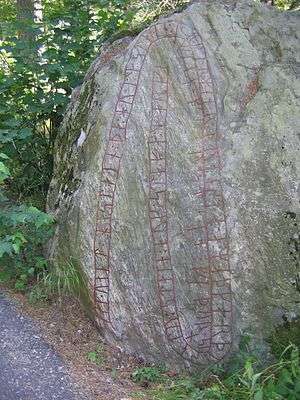Fyrby Runestone

The Fyrby Runestone, which is designated as Sö 56 in the Rundata catalog, is a Viking Age memorial runestone located in Fyrby, which is about 15 kilometers south of Flen, Södermanland County, Sweden, and in the historic province of Södermanland.
Description
The runic inscription on the Fyrby Runestone consists of runic text within a band that curves along the face of the north side of a granite boulder that is two meters in height. The runic inscription is classified as being carved in runestone style RAK. RAK is the classification for the oldest style where the ends of the runic bands are straight and there are no animal designs. The inscription is considered somewhat enigmatic due to its use of the pronoun "I" at the beginning of the runic text, which might even refer to the stone itself speaking to the reader.[1] This runestone is notable for its reference to Midgard ("Middle Earth"), which was one of the nine worlds of Norse cosmology and the home of humans. The period that Anne-Sofie Gräslund proposed [2] for the RAK style was 990-1010 AD.
The runic text indicates that the inscription is a memorial to a father from his two sons which also boasts of the skills of the sons in rune-making,[1] claiming that the brothers were the most skilled in runes in Miðgarði or "Middle Earth". One personal name in the inscription contains the name of the Norse pagan god Freyr as a theophoric name element. The father's name, Freysteinn, means "Freyr's Stone."[3] In addition, the Hár or "High" in the name Hásteinn, which means "High Stone," may refer to the byname Hár of the god Odin.[4] The names in the Fyrby Runestone inscription also reflect a common practice of that time in Scandinavia of repeating an element in a parent's name in the names of the children.[5] Here the steinn from the father's name, Freystein, is repeated in the names of the two sons, Hásteinn and Holmsteinn, to show the family relationship. The statement that the sons placed stafa marga or "many staffs" in memory of their father may refer to the staves of the runes in the text.[6] Two other inscriptions, DR 40 in Randbøl and Sm 16 in Nöbbele, make explicit use of the word "staff" to refer to runes.[6] Other inscriptions which use the word in reference to the raising of a staff as a monument include Sö 196 in Kolsundet, Vs 1 in Stora Ryttern, U 226 in Bällsta, the now-lost U 332 in Vreta, and the now-lost U 849 in Balingsta.[6]
Inscription
In Unicode
- ᛁᛅᚴ᛫ᚢᛅᛁᛏ᛬ᚼᛅᛋᛏᛅᛁᚾ᛬ᚦᛅ᛬ᚼᚢᛚᛘᛋᛏᛅᛁᚾ᛬ᛒᚱᚢᚦᚱ᛫ᛘᛂᚾᚱ᛬ᚱᚢᚾᛅᛋᛏᛅ᛬ᛅ᛬ᛘᛁᚦᚴᛅᚱᚦᛁ᛬ᛋᛂᛏᚢ᛬ᛋᛏᛅᛁᚾ᛬ᛅᚢᚴ᛬ᛋᛏᛅᚠᛅ᛬ᛘᛅᚱᚵᛅ
- ᛂᚠᛐᛁᛦ᛫ᚠᚱᛅᚤᛋᛏᛅᛁᚾ᛬ᚠᛅᚦᚢᚱ᛫ᛋᛁᚾ
Transliteration of the runes into Latin characters
.jpg)
- iak * uait : hastain : þa : hulmstain : bryþr * menr : rynasta : a : miþkarþi : setu : stain : auk : stafa : marga eftiʀ * fraystain * faþur * sin *[7]
Transcription into Old Norse
- Ek veit Hástein þá Holmstein brœðr menn rýnasta á Miðgarði, settu stein ok stafa marga eptir Freystein, fôður sinn.[7]
Translation in English
- I know Hásteinn and Holmsteinn, the most rune-skilled brothers in Midgard (Middle Earth), placed many a stone and staff in memory of Freysteinn, their father.[7]
Alliterative verse
It has been noted that the inscription on the Fyrby Runestone can be read in the form of alliterative verse known as Fornyrðislag:[1]
Ek veit Hastein
þa Holmstein brœðr
mennr rynasta
á Migarði
settu stein
ok stafa marga
eftir Frøsten
faður sin[8]I know Hásteinn
and Holmsteinn
the most rune-skilled brothers
in Middle Earth
placed many a stone
and staff in memory
of Freysteinn
their father
See also
References
- 1 2 3 Jesch, Judith (1998). "Still Standing in Ågersta: Textuality and Literacy in Late Viking-Age Rune Stone Inscriptions". In Hoops, Johannes; et al. Reallexikon der Germanischen Altertumskunde. Walter de Gruyter. pp. 462–475. ISBN 3-11-015455-2. p. 471-472.
- ↑ Gräslund, Anne-Sofie (2006), "Dating the Swedish Viking-Age Rune Stones on Stylistic Grounds", Runes and Their Secrets: Studies in Runology, Copenhagen: Museum Tusculanum Press, pp. 117–140, ISBN 87-635-0428-6
- ↑ Grimm, Jacob (1888). Teutonic Mythology. 4. Translated by Stallybrass, James Steven. London: George Bell and Sons. p. 1355.
- ↑ Cleasby, Richard; Vigfússon, Guðbrandur (1878). An Icelandic-English Dictionary. Clarendon Press. pp. 243–244.
- ↑ Peterson, Lena (2002). "Developments of Personal Names from Ancient Nordic to Old Nordic". In Bandle, Oskar; Elmevik, Lennart; et al. The Nordic Languages: An International Handbook of the History of the North Germanic Languages. 1. Walter de Gruyter. pp. 745–753. ISBN 3-11-014876-5. p. 750.
- 1 2 3 Zilmer, Kristel (2005). ""He Drowned in Holmr's Sea - His Cargo-Ship Drfted to the Sea-Bottom, Only Three Came Out Alive": Records and Representations of Baltic Traffic in the Viking Age and Early Middle Ages in Early Nordic Sources" (PDF). Tartu University Press (Diss.): 156. ISBN 9949-11-090-4.
- 1 2 3 Project Samnordisk Runtextdatabas Svensk - Rundata entry for Sö 56.
- ↑ Skaldic Poetry of the Scandinavian Middle Ages
External links
Coordinates: 58°57′12″N 16°40′08″E / 58.9533°N 16.6689°E